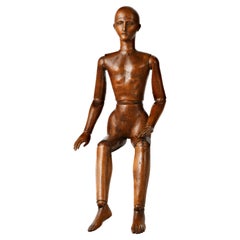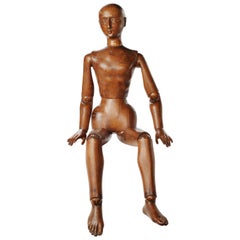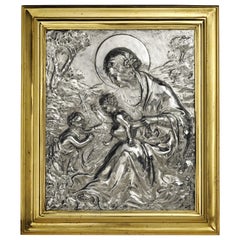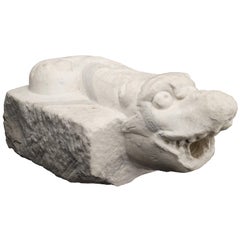Video Loading
Want more images or videos?
Request additional images or videos from the seller
1 of 20
20th Century Italian Life-Size Mannequin, circa 1920
Price:$26,880.36
$48,133.87List Price
About the Item
- Dimensions:Height: 68.51 in (174 cm)Width: 16.54 in (42 cm)Depth: 13.19 in (33.5 cm)
- Style:Other (Of the Period)
- Materials and Techniques:
- Place of Origin:
- Period:
- Date of Manufacture:circa 1920
- Condition:Minor fading. Almost perfect, with the exception of a vertical slit on the face.
- Seller Location:Milano, IT
- Reference Number:1stDibs: LU4352214037692
About the Seller
4.3
Vetted Professional Seller
Every seller passes strict standards for authenticity and reliability
Established in 1860
1stDibs seller since 2018
21 sales on 1stDibs
Associations
International Confederation of Art and Antique Dealers' Associations
Authenticity Guarantee
In the unlikely event there’s an issue with an item’s authenticity, contact us within 1 year for a full refund. DetailsMoney-Back Guarantee
If your item is not as described, is damaged in transit, or does not arrive, contact us within 7 days for a full refund. Details24-Hour Cancellation
You have a 24-hour grace period in which to reconsider your purchase, with no questions asked.Vetted Professional Sellers
Our world-class sellers must adhere to strict standards for service and quality, maintaining the integrity of our listings.Price-Match Guarantee
If you find that a seller listed the same item for a lower price elsewhere, we’ll match it.Trusted Global Delivery
Our best-in-class carrier network provides specialized shipping options worldwide, including custom delivery.You May Also Like
Life Size Leopard Mount Italian Terracotta Mid 20th Century
Located in Rochester, NY
Life size leopard wall mount. Hand painted terracotta. Italian. Mid 20th century.
# modern Hollywood regency animal cat
Category
Mid-20th Century Italian Figurative Sculptures
Materials
Majolica, Terracotta
Life-Size Bronze Bear Sculpture, Italian Foundry, 20th Century
Located in Madrid, ES
Impressive life-size bronze sculpture of a bear, cast in Naples, Italy, during the 20th century. This striking piece is executed with remarkable realism and attention to anatomical d...
Category
1990s Figurative Sculptures
Materials
Bronze
$15,102
H 78.75 in W 23.63 in D 19.69 in
19th Century Italian Female Mannequin Life-Size Artists Lay Figure
Located in Milano, MI
Life-Size Artist Mannequin Italy circa 1870, 19th century articulated lay figure, a carved beech life-size female figure of almost 66 inches, da...
Category
Antique Late 19th Century Italian Figurative Sculptures
Materials
Wood
$30,083
H 65.75 in W 15.75 in D 7.49 in
Early 20th Century French Wooden Mannequin
Located in High Point, NC
Capture the essence of early 20th-century French craftsmanship with this Antique French Wooden Mannequin. Crafted with precision, this unique p...
Category
Early 20th Century French Figurative Sculptures
Materials
Wood
French Tailor's Mannequin, early 20th Century
Located in Berghuelen, DE
French Tailor's Mannequin, early 20th Century
French 20th century tailor's mannequin. Made of paper, fabric and metal. It features a mechanism inside which allows the tailor to adju...
Category
Early 20th Century French Folk Art Mobiles and Kinetic Sculptures
Materials
Metal
Antique 20th Century Italian Green Marble Life Size Bust On Stand c.1900
Located in Royal Tunbridge Wells, Kent
Crafted in the 20th Century, this Antique Italian green marble sculpture depicts the bust of a sorrowful young man gazing to his right. Resting upon a two-part pedestal crafted from ...
Category
Antique Early 1900s Italian Other Busts
Materials
Marble
$15,836
H 86.23 in W 20.48 in D 20.48 in
Life-Sized Dayak Tribe Female "Hampatong" Guardian, Borneo, Early 20th Century
Located in Jimbaran, Bali
‘Hampatong’ is the term used for ancestors and protective figures made of hard ‘iron wood’, which the Dayak of Borneo would position infront of their houses as guardians. This early ...
Category
Early 20th Century Indonesian Other Sculptures and Carvings
Materials
Wood
$6,845
H 76.78 in W 17.72 in D 16.93 in
Early 20th Century Life Size Carved Female Torso
Located in Martlesham, GB
A fabulous quality Early 20th Century life size carved female torso in the classical style, very well executed in wonderfully figured walnut, the sculpture is in excellent condition ...
Category
Vintage 1930s British Figurative Sculptures
Materials
Walnut
Early 20th century terracotta Paris shop display mannequin
Located in London, GB
Early 20th century terracotta Paris shop display mannequin
A rare survivor, in the form of a life size terracotta Paris display boy mannequin. With inserted glass eyes and central ...
Category
Early 20th Century French Late Victorian Figurative Sculptures
Materials
Terracotta
Italian 19th-20th Century Life-Size Marble Sculpture Titled "Searching for Love"
By Vito Pardo
Located in Los Angeles, CA
A very fine museum quality Italian 19th-20th century life-size marble sculpture titled "Searching for Love" by Vito Pardo (Italian, born in Venice in 1872) Depicting a semi-nude life...
Category
Antique Early 1900s Italian Rococo Figurative Sculptures
Materials
Marble, Bronze
$219,600 Sale Price / set
44% Off
H 121 in W 28 in D 25 in
More From This Seller
View All19th Century Italian Wood Mannequin, Circa 1870-1880
Located in Milano, IT
Mannequin
Sculpted and carved wood
Italy or France, second half of the 19th century.
It measures 25.59 x 6.29 x 3.54 in (65.5 x 16 x 9 cm)
It weighs 2.2 lb circa (1 kg circa)
St...
Category
Antique 1870s Italian Other Figurative Sculptures
Materials
Wood
Late 19th Century Italian Wood Mannequin, circa 1880
Located in Milano, IT
Atelier mannequin
graven and carved stone pine wood
Italy, late 19th century
Measures: H 102 cm x 25 cm x 14 cm
H 40.15 in x 9.84 in x 5.51 in
Weight: circa kg 4
State of conse...
Category
Antique 1880s Italian Other Figurative Sculptures
Materials
Wood
19th Century Italian Sterling Silver Madonna, circa 1830
Located in Milano, IT
Embossed and engraved silver plaque
La Madonna del lago (The Madonna of the Lake)
Probably Milan, post 1824
Brass frame
It measures 16.14 in x 13.85 in (41 x 35.2 cm) and it weighs 10.357 pounds (4.698 g): silver 1.31 pounds (598 g) + brass 9.03 pounds (4.100 g)
State of conservation: some abrasions on the bottom. The frame is old, but not original.
The plaque is made up of a sheet of embossed and engraved silver, and held in a solid brass frame. It depicts the “Madonna del lago” – “Madonna of the Lake” - (the Madonna with Child and San Giovannino) by Marco d'Oggiono (Oggiono, 1474 circa - Milan, 1524 circa), while changing only the background landscape. Almost certainly the subject reproduced in the plaque was taken from a famous engraving by Giuseppe Longhi (Monza, 1766 - Milan, 1831), one of the greatest engravers of his era.
The silver is unmarked, probably because originally the Madonna was due to be exposed in a church: sometimes precious metals destined for worship and liturgical use would be exempted from payment and were, therefore, not marked.
It is very likely that the plaque was made in Milan because in this city in 1824 the engraving by Giuseppe Longhi was made and printed. In addition, in Milan, the alleged lost painting by Leonardo da Vinci in his Milanese period (1482-1500) would be produced; this is the painting from which Marco d'Oggiono took his version.
The painting
Marco d?Oggiono was one of Leonardo da Vinci's most brilliant students and collaborators (D. Sedini, Marco d’Oggiono, tradizione e rinnovamento in Lombardia tra Quattrocento e Cinquecento, Roma 1989, pp. 151-153, n. 56; p. 225, n. 124, with previous bibliography). His style reflects in every way that of the Tuscan Maestro, so much so that he was the one who executed some copies of da Vinci's paintings. The execution of the “Madonna del Lago” probably draws inspiration from a lost painting by the Maestro, created while he was living in Milan (1482-1500). There are many similarities with other works by Leonardo such as the “Vergine delle rocce” or the “Vergine con il Bambino e San Giovannino, Sant’Anna e l’Agnello”.
The painting, from which the drawing and then the famous engraving were taken, is found today at the M&G Museum of Bob Jones University in Greenville, South Carolina, where it came to rest after the sale of the Harrington Collection in London in 1917.
The work appears in the inventories of the collection of Napoleon and Joséphine Bonaparte at the castle of Malmaison, before 1809.
The Malmaison building was born and developed in the 17th and 18th centuries. In the 18th century it belonged to Jacques-Jean Le Coulteux du Molay, a wealthy banker. Later, during the Directory, Joséphine Bonaparte de Beauharnais bought it on April 21st, 1799, but settled at the castle definitively only after her husband separated from her in 1809. She remained there until 1814, the year of her death. When Joséphine died, the estate passed to her son Eugène de Beauharnais, who moved to Munich with his whole family in 1815, bringing with him the collection of paintings he inherited from his mother. Eugène died in 1824 and his wife Augusta of Bavaria (von Bayern), unable to keep it, in 1828 sold the Malmaison to the Swedish banker Jonas-Philip Hagerman.
It is likely that in this period Augusta also sold part of the paintings inherited from her husband, including the “Madonna del Lago”. This painting then came into the possession of Leicester Stanhope, fifth Earl of Harrington (1784 - 1862) and then was passed down to his descendants.
In 1917, at the death of Charles, eighth Earl of Harrington, his brother Dudley inherited the title and properties and he put up a part of his collections for sale. Among these, precisely, the painting by Marco d'Oggiono was to be found.
On the occasion of that auction the painting was presented as a work by Cesare da Sesto, by virtue of a handwritten note by the Countess of Harrington on the back of the table. However, already in 1857, the German critic Gustav Waagen had identified Marco d'Oggiono as the author of the painting, then exhibited in the dining room of Harrington House in London (Treasures of Art in Great Britain, in 4 volumes, London, 1854 and 1857).
The engraving
Giuseppe Longhi was one of the most renowned engravers in Italy between the end of the 18th century and the first quarter of the 19th century.
In 1824 Giuseppe Longhi, based on a design by Paolo Caronni, made a famous engraving of the painting of Marco d?Oggiono. The activity of Longhi was then at the peak of his notoriety, enough to earn him very substantial commissions; it is not risky to suppose that some of his successful engravings were also reproduced using other means: in our case in silver. (A. Crespi, a cura di, Giuseppe Longhi 1766–1831 e Raffaello Morghen...
Category
Antique 1820s Italian Neoclassical Sterling Silver
Materials
Sterling Silver, Brass
Italian Ancient Marble Sculpture Fountain, Late 16th Century
Located in Milano, IT
Sea monster
Carrara marble mouth fountain
Italy, late 16th century
It measures 13.8 x 31.5 x 18.9 in (35 x 80 x 48 cm)
State of conservation: some small evident gaps and widespread signs of wear due to outdoor exposure. The gray marks crossing it do not come from restoration, but are rather the natural veins of the marble.
This work has some morphological characteristics typically associated with the iconography of the sea monster: an elongated muzzle, sharp teeth, protruding eyes, elongated ears, and a coiled serpent's tail.
An in-depth series of studies on artistic depictions of the sea monster attempted to verify how this symbol evolved in antiquity in the European and Mediterranean contexts and how it gradually changed its image and function over time. The iconography itself is mutable and imaginative and its history is rich with cultural and artistic exchange, as well as the overlapping of ideas. This occurred so much that it is difficult to accurately pinpoint the "types" that satisfactorily represent its various developments.
However, we can try to summarize the main figures, starting from the biblical Leviathan and the marine creature that swallowed Jonah (in the Christian version, this figure was to become a whale or a "big fish", the “ketos mega”, translation of the Hebrew “dag gadol”). Other specimens ranged from the dragons mentioned in the Iliad (which were winged and had legs) to "ketos” (also from Greek mythology), the terrifying being from whose Latinized name (“cetus”) derives the word "cetacean". See J. Boardman, “Very Like a Whale” - Classical Sea Monsters, in Monsters and Demons in the Ancient and Medieval Worlds, in Papers presented in Honor of Edith Porada, Mainz am Rhein 1987, pp. 73-84).
In Italy the monster underwent yet further variations: it can be found in Etruscan art on the front of some sarcophagi representing the companion of souls, while among the Romans we find the “Pistrice” (cited by Plinio in Naturalis Historia PLIN., Nat., II 9, 8 and by Virgilio in Eneide: VERG., Aen., III, 427), which appeared in the shape of a stylized hippocampus or a very large monstrous cetacean and evolved into a hideous being with a dragon's head and long webbed fins.
During the Middle Ages, the sea monster was the object of new transformations: at this time, it is often winged, the head is stretched like a crocodile, the front legs are often very sharp fins - sometimes real paws - until the image merges with dragons, the typical figures of medieval visionary spirituality widely found throughout Europe (on this topic and much more, see: Baltrušaitis, J., Il Medioevo fantastico. Antichità ed esotismi nell’arte gotica, Gli Adelphi 1997).
In Italy during the 15th and 16th centuries, the revival of classicism - representative of the humanistic and Renaissance periods - led to a different reading of these "creatures". Indeed, the sea monster was also to find widespread use as an isolated decorative motif, especially in numerous fountains and sculptures where dolphins or sea monsters were used as a characterizing element linked to water (on this theme see: Chet Van Duzer, Sea Monsters on Medieval and Renaissance Maps, London, The British library, 2013).
From the morphological point of view, the "sea monsters" of this period are mostly depicted as hybrid figures, in which the body of a mythological or real being (a hippocampus, a sea snake, a dolphin), is joined to a head with a rather indistinct appearance. It was usually characterized by large upright ears, an elongated snout, sharp teeth and globular, protruding eyes; a complex and indefinite figure, both from the symbolic point of view and from that of its genesis.
The work we are examining is placed as a cross between the medieval sea serpent and the Renaissance dolphin, with stylistic features which recall the snake as often used in heraldry (such as the "snake" depicted in the coat of arms of the Visconti - the lords and then dukes of Milan between 1277 and 1447 - and which, for some, may be derived from the representations of the “Pistrice” that swallowed Jonah).
In the search for sources, Renaissance cartography and in particular woodcuts should not be neglected. See for example the monsters of Olaus Magnus, from the editions of the “Historia de gentibus septentrionalibus” (“History of the peoples of the north”) and the natural histories of Conrad Gesner, Ulisse...
Category
Antique 16th Century Italian Renaissance Animal Sculptures
Materials
Carrara Marble
Crucifix, Bronze, iron, and wood, Lombardy, mid-17th century
Located in Milano, IT
Crucifix
Lombardy, mid-17th century
Bronze, iron, and wood
Sculpture: 33 cm height x 35 cm width x 10 cm depth at the knees;
Cross: 42.12 in height x 19.68 in width (107 cm x 50);
Ba...
Category
Antique Mid-17th Century Italian Baroque Figurative Sculptures
Materials
Bronze, Iron
Ancient Boxwood Micro Carving Deposition, First Half of the 18th Century
Located in Milano, IT
Boxwood micro carving
Deposition
Central Europe, first half of the 18th century
It measures: the sculpture 7.40 x 5.31 x 0.6 in (18.8 x 13.5 x 1.6 cm); w...
Category
Antique 1740s European Baroque Figurative Sculptures
Materials
Boxwood
Recently Viewed
View AllMore Ways To Browse
Italian Mannequin
Lay Figure
Antique Artist Mannequin
Antique Fetish
Antique Lay Figure
Human Effigies
Life Size Mannequins
19th Century French Articulated Wood Artists Mannequin
Greece Vintage
Italian Cherub
Roman Goddess
Cluster Of Grapes
Antique Nude Male
Bronze Sculptures Of Woman
African Wood Sculptures
Bronze Sculpture 1950
Ceramic Woman
Spanish Antique Sculpture



